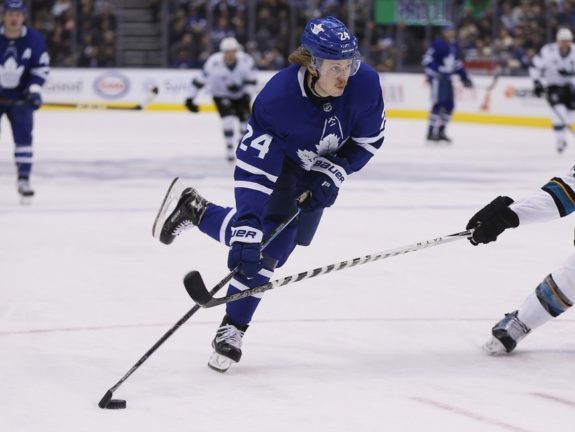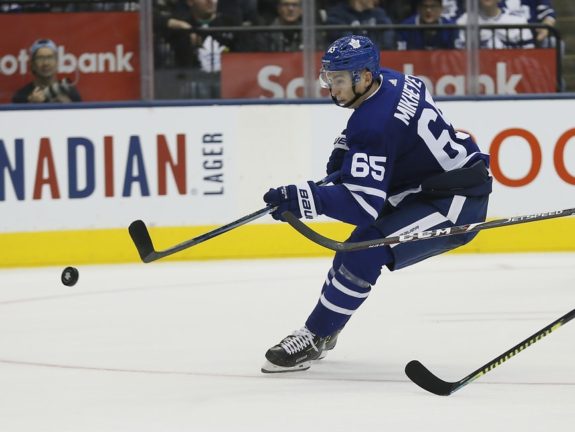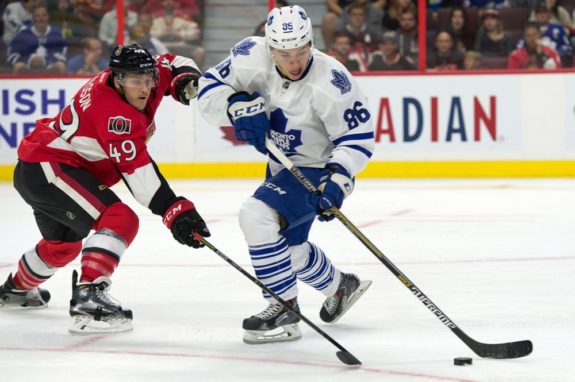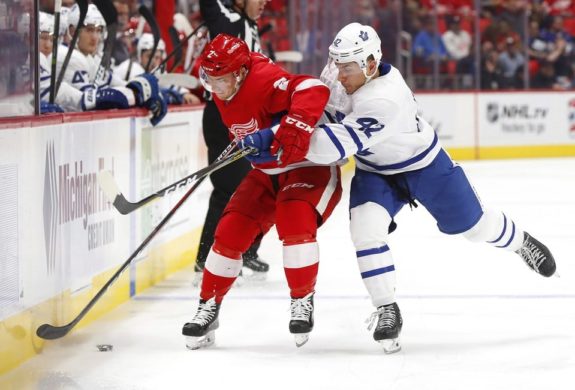We’re four games into the Toronto Maple Leafs 2019-20 campaign and there’s already plenty to take about. After opening with two straight wins, the team has dropped back-to-back contests, although Monday’s hard-fought loss to the St. Louis Blues represented a big bounce-back effort, result aside.
There’s not much room for moral victories in the NHL, so look for the Maple Leafs to buckle down and come out hard against the seemingly struggling Tampa Bay Lighting on Thursday night before a showdown with the Detroit Red Wings on Saturday.
Of the many topics of discussion in Leafs Nation is the new-look forward group and how Mike Babcock has deployed this group so far. Kasperi Kapanen’s slow start has further complicated matters while others on the Maple Leafs have flourished in the early going with chemistry abound.
With that in mind, let’s take a look at the Maple Leafs’ current line combinations up front and see if the line is working or not and the reasons for the success and failures. I’ll end the discussion by taking a look at some options moving forward to ensure this dynamic group is rolling on all cylinders moving forward.
Line 1: Johnsson / Matthews / Nylander
Last season, the John Tavares line was dubbed the Maple Leafs’ top line; however, that hasn’t been the case this season as the Auston Matthews trio has been the Maple Leafs most potent line in the early going.

William Nylander’s potential bounceback season was an integral part to this team’s offense thanks to his once-elite chemistry with Matthews from season’s past. For those of you who haven’t been watching, the duo has been absolutely dominant in the early going.
Through the first four games of the season, Matthews and Nylander have combined for seven goals and nine points, a plus-five rating and 32 shots on goal. In addition to the raw numbers, the duo has absolutely dominated the possession game. Nylander owns an enormous 60.2% Corsi For% (CF%) at even strength while Matthews’ 59.3% CF% at even strength isn’t too shabby, either.
Nylander made no bones that he was a confident man ready to dominate entering this season after following up a shaky NHL season with a substantially productive World Championship last May. Maple Leafs brass and fans alike are certainly thrilled to see their 23-and-under dynamic duo back on the same page. While it’s early, it appears there are new heights to be reached before this season is over.
For his part, Andreas Johnsson has been the pest on the line responsible for taking the beatings in front of the net and behind the goal line, and he’s done an admirable job in doing so. The results haven’t shown up on the scoresheet yet with just one assist through four games, but don’t expect Johnsson to go anywhere given the way these three have meshed in the early going.
Line 2: Kapanen / Tavares / Marner
Both the eye test and stat sheet tell us that this newly-formed line hasn’t quite clicked as hoped in the first few games and Kapanen is taking the brunt of the blame. After throwing his broken stick and causing a game-tying penalty shot goal — along with plenty of embarrassment on his part — Kapanen came back with a solid game on Monday against the Blues, but the results continue to evade him.

While the finger-pointing at Kapanen takes place, the eye test alone tells us that Marner and Tavares haven’t clicked nearly as well this season as they did in setting new career-highs together in 2018-19. While the duo teamed up for a pair of tallies in their Friday night win against the Blue Jackets, the chemistry has largely been invisible and Tavares, like Kapanen, is without a goal to this point.
The advanced numbers don’t paint quite the doomsday picture that many Leafs fans are ranting about on their Twitter accounts. All three players are positive possession players at even strength while Kapanen and Marner are key pieces in a Maple Leafs penalty kill that ranks 10th with a nice 85.7% success rate this season.
While I have my own positive and negative conclusions in regards to head coach Mike Babcock, I’d have to side with him on this one. After a couple years of fans battering the head coach for using Zach Hyman in top-line roles, all of a sudden his forechecking and puck-retrieval skills are sorely missed on the Tavares line.
Babcock’s cheekiness aside, he’s correct in explaining that the Tavares line, as it stands today, needs to be dominant. With two more games in three days beginning Thursday, they will get their chance to get things turned around.
Line 3: Mikheyev / Kerfoot / Moore
Among positive surprises on the 2019-20 version of the Maple Leafs, Ilya Mikheyev’s name has to be at the top. The 24-year-old Russian has impressed with his puck-hounding skills and swift skating for a player that stands 6-foot-3. He’s also become a difference maker and an offensive threat on the penalty kill.

His emergence has been a boon to the Maple Leafs depth this season, as has linemate Trevor Moore who looks vastly improved from the player that burst onto the scene and onto the club’s postseason roster after spending the majority of the season with the American Hockey League’s Toronto Marlies. His two-year contract extension in January now looks like a stroke of genius on behalf of general manager Kyle Dubas.
Add in Alexander Kerfoot’s 200-foot presence — as well as three points in four games — and this line has been dynamite for the club in the early going. Mikheyev has matched his centre’s production with a goal and a pair of helpers on the season while Moore owns the reverse stats in the form of two goals and an assist.
There’s no doubt this line has lengthened the offensive depth of the club as they sit eighth in league scoring through a tiny sample size this season. Their forward depth became a question mark with Kapanen moving from the projected third line to the top line, but this line has done a very nice job of stepping up at the offensive end while remaining responsible in their own third of the ice. The trio is a combined plus-six so far this season.
Line 4 (Version 1): Petan / Gauthier / Spezza
I declared this version of the fourth line version one as I believe it will be the trio Babcock will roll with most often moving forward as he continues to rotate Petan and Spezza in and out of the lineup.

Meanwhile, Frederik Gauthier, the forgotten man when Spezza signed with the team on July 1, has skated in all four games this season and even has a couple of goals to his credit. There’s little doubt that Gauthier has worked his way into Babcock’s good books, but I’m convinced he’ll need to improve his early-season 42.9% rate on faceoffs in order to avoid the rotation being deployed to this point.
In all honesty, this version of the fourth line is the only version generating offense and winning the possession battle. Take Nic Petan, for instance. Petan is averaging just 6:18 of ice time per game in two games played, but he owns an eye-popping 78.6 CF%. Furthermore, he’s accomplished that feat despite starting a whopping 90.9% of his shifts in the defensive end of the ice.
Same goes for Spezza, only to a more emphatic extent. In two games, while averaging only 9:39 of ice time per game, he owns a massive 91.3% CF% at even strength. The opposition has managed just two shot attempts while he has been on the ice this season at even strength. He was also responsible for Gauthier’s second goal of the season on Monday night.
Yes, two games is one game away from being the smallest sample size possible. However, this fourth line has certainly been the better fourth line and it would stand to reason they get the benefit of the doubt moving forward.
Line 4 (Version 2): Timashov / Gauthier / Shore
Dmytro Timashov is almost certainly going back to the Marlies once Hyman returns, but despite already notching his first NHL point, he hasn’t been all too impressive and clearly requires more seasoning. The Maple Leafs knew what they were going to get with Nick Shore, but his play through a pair of games has left much to be desired.

Timashov owns a 35% CF% at even strength this season while Shore sits at just 37.1%. Shore has been dominant in the faceoff circle with a 65% rate, but the Maple Leafs also have Gauthier and a right-handed Spezza set to share draws on fourth line version one. Both were excellent in the faceoff circle last season — especially in the defensive zone.
Timashov needs some more seasoning, and Petan needs an opportunity at the NHL level right now after not getting much of one with the Jets following a storied junior career with the Western Hockey League’s Portland Winterhawks. Spezza easily gets the nod over Shore thanks to his ability to take faceoffs and play on the second power play unit. He’s by far the superior offensive player, not to mention his 16 years of NHL experience on one of the NHL’s youngest rosters.
Babcock will likely continue to rotate for now — much to the chagrin of many reading this — but to me it’s been vehemently clear who the better version of the fourth line has been this season, and yes they are indeed working out to this point.
What Can Change?
As noted, there’s been much clambering about getting Kapanen off the top line and back onto his natural right-wing side next to Kerfoot on the Maple Leafs’ third line. This is where the biggest potential lineup adjustment could be had.

You would hate to mess with the success that the club’s third line is enjoying, but if Kapanen’s early-season struggles continue a whole lot longer, a change is probably in the Maple Leafs’ best interest. To me, there’s only two candidates to move up to the left of Tavares and Marner: Mikheyev and Moore.
Both are left-handed shots, so there’s no worries about another off-wing scenario. The real interesting part here is that both are cut from the Hyman cloth: speedy, puck-chasing wingers who win battles below the goal line. Mikheyev has displayed such attributes in his brief NHL career while Moore became a quick Babcock favorite last season thanks to his tenacity in the dirty areas of the ice. He’s been the most rumored man to make the jump.
Babcock is going to give Kapanen a longer leash. How much longer that leash is remains to be seen. If he can’t find success and gel with his new linemates, expect Mikheyev or Moore to move up the lineup and allow the fleet-footed Finn to work his magic back on his natural wing.
Aside from giving the Petan-Gauthier-Spezza trio more reps on the fourth line, moving a third-line piece to the Tavares line would represent a notable change in the forward ranks. Otherwise, let the early-season kinks worth their way out and move on to what should be another productive season with this dynamic and dangerous Maple Leafs offense.